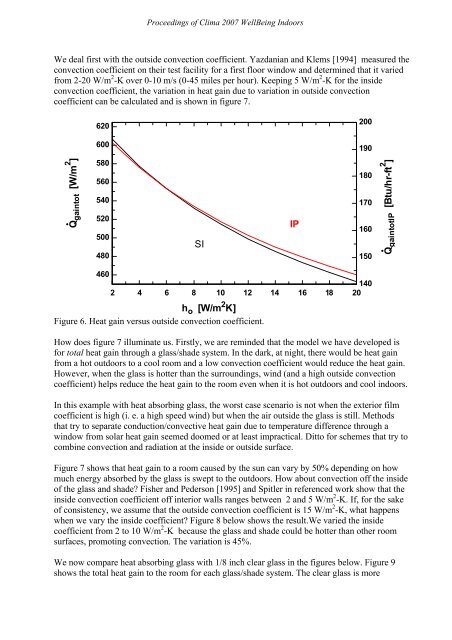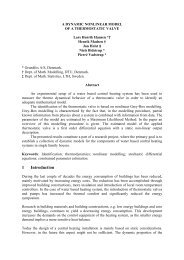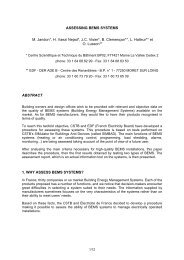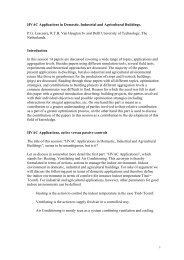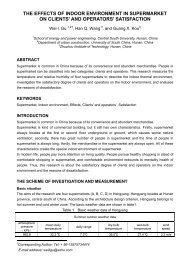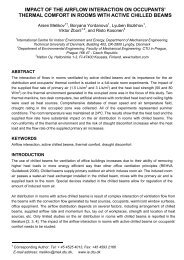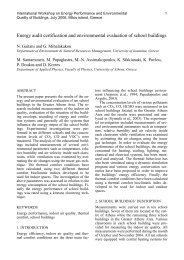Modeling the Heat Gain of a Window With an Interior Shade ... - inive
Modeling the Heat Gain of a Window With an Interior Shade ... - inive
Modeling the Heat Gain of a Window With an Interior Shade ... - inive
Create successful ePaper yourself
Turn your PDF publications into a flip-book with our unique Google optimized e-Paper software.
Proceedings <strong>of</strong> Clima 2007 WellBeing Indoors<br />
We deal first with <strong>the</strong> outside convection coefficient. Yazd<strong>an</strong>i<strong>an</strong> <strong>an</strong>d Klems [1994] measured <strong>the</strong><br />
convection coefficient on <strong>the</strong>ir test facility for a first floor window <strong>an</strong>d determined that it varied<br />
from 2-20 W/m 2 -K over 0-10 m/s (0-45 miles per hour). Keeping 5 W/m 2 -K for <strong>the</strong> inside<br />
convection coefficient, <strong>the</strong> variation in heat gain due to variation in outside convection<br />
coefficient c<strong>an</strong> be calculated <strong>an</strong>d is shown in figure 7.<br />
620<br />
200<br />
600<br />
190<br />
Q gaintot [W/m 2 ]<br />
580<br />
560<br />
540<br />
520<br />
500<br />
480<br />
SI<br />
IP<br />
180<br />
170<br />
160<br />
150<br />
Q gaintotIP [Btu/hr-ft 2 ]<br />
460<br />
140<br />
2 4 6 8 10 12 14 16 18 20<br />
h o [W/m 2 K]<br />
Figure 6. <strong>Heat</strong> gain versus outside convection coefficient.<br />
How does figure 7 illuminate us. Firstly, we are reminded that <strong>the</strong> model we have developed is<br />
for total heat gain through a glass/shade system. In <strong>the</strong> dark, at night, <strong>the</strong>re would be heat gain<br />
from a hot outdoors to a cool room <strong>an</strong>d a low convection coefficient would reduce <strong>the</strong> heat gain.<br />
However, when <strong>the</strong> glass is hotter th<strong>an</strong> <strong>the</strong> surroundings, wind (<strong>an</strong>d a high outside convection<br />
coefficient) helps reduce <strong>the</strong> heat gain to <strong>the</strong> room even when it is hot outdoors <strong>an</strong>d cool indoors.<br />
In this example with heat absorbing glass, <strong>the</strong> worst case scenario is not when <strong>the</strong> exterior film<br />
coefficient is high (i. e. a high speed wind) but when <strong>the</strong> air outside <strong>the</strong> glass is still. Methods<br />
that try to separate conduction/convective heat gain due to temperature difference through a<br />
window from solar heat gain seemed doomed or at least impractical. Ditto for schemes that try to<br />
combine convection <strong>an</strong>d radiation at <strong>the</strong> inside or outside surface.<br />
Figure 7 shows that heat gain to a room caused by <strong>the</strong> sun c<strong>an</strong> vary by 50% depending on how<br />
much energy absorbed by <strong>the</strong> glass is swept to <strong>the</strong> outdoors. How about convection <strong>of</strong>f <strong>the</strong> inside<br />
<strong>of</strong> <strong>the</strong> glass <strong>an</strong>d shade? Fisher <strong>an</strong>d Pederson [1995] <strong>an</strong>d Spitler in referenced work show that <strong>the</strong><br />
inside convection coefficient <strong>of</strong>f interior walls r<strong>an</strong>ges between 2 <strong>an</strong>d 5 W/m 2 -K. If, for <strong>the</strong> sake<br />
<strong>of</strong> consistency, we assume that <strong>the</strong> outside convection coefficient is 15 W/m 2 -K, what happens<br />
when we vary <strong>the</strong> inside coefficient? Figure 8 below shows <strong>the</strong> result.We varied <strong>the</strong> inside<br />
coefficient from 2 to 10 W/m 2 -K because <strong>the</strong> glass <strong>an</strong>d shade could be hotter th<strong>an</strong> o<strong>the</strong>r room<br />
surfaces, promoting convection. The variation is 45%.<br />
We now compare heat absorbing glass with 1/8 inch clear glass in <strong>the</strong> figures below. Figure 9<br />
shows <strong>the</strong> total heat gain to <strong>the</strong> room for each glass/shade system. The clear glass is more


